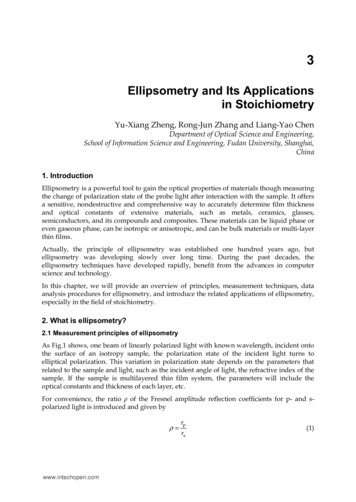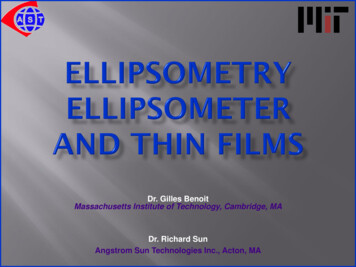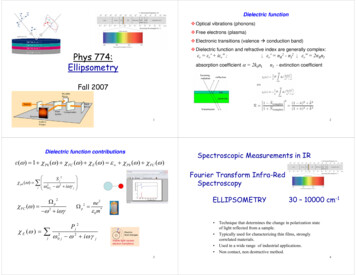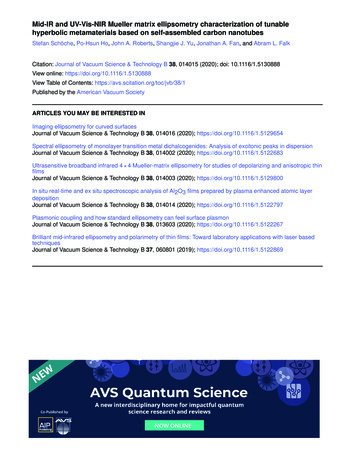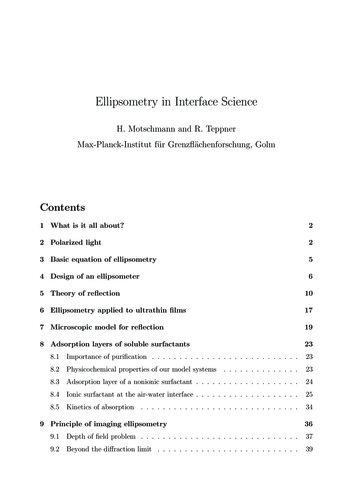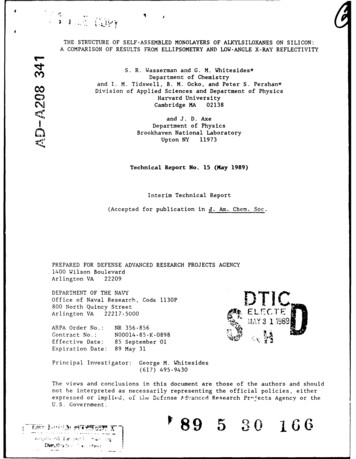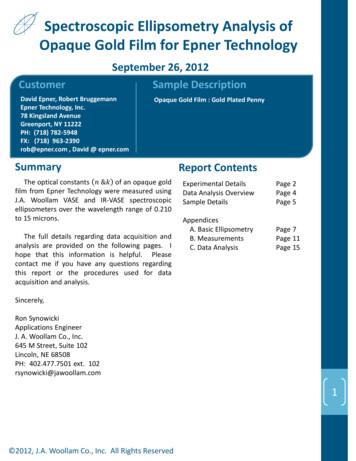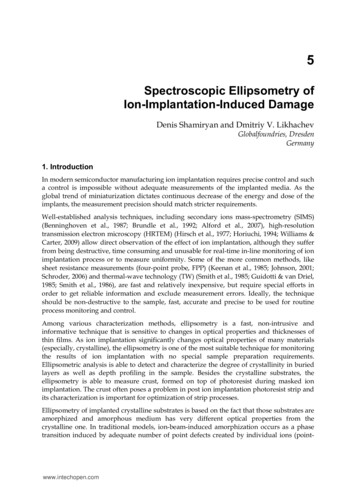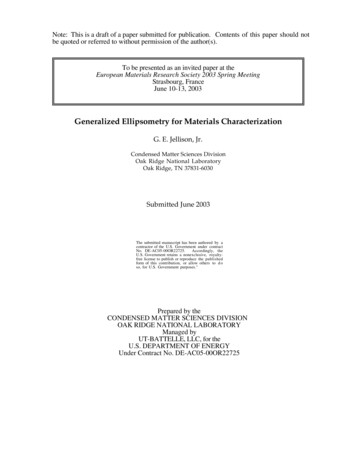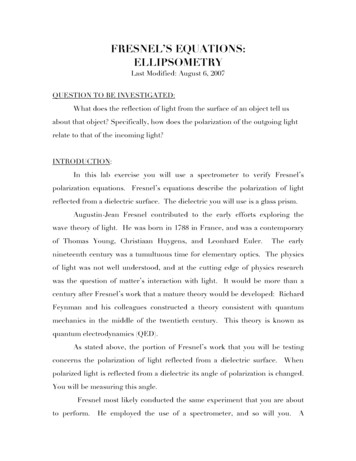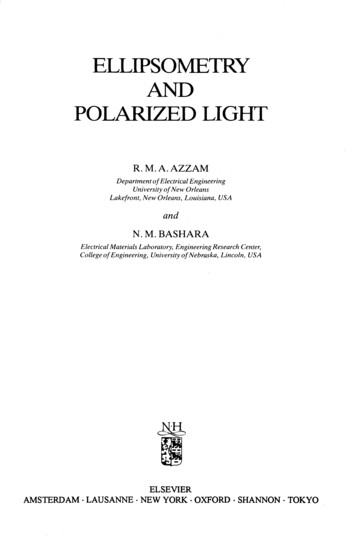
Transcription
ELLIPSOMETRYANDPOLARIZED LIGHTR.M.A.AZZAMDepartment of Electrical EngineeringUniversity of New OrleansLakefront, New Orleans, Louisiana, USAandN . M . В ASH AR AElectrical Materials Laboratory, Engineering Research Center,College of Engineering, University of Nebraska, Lincoln, USANiljjfflmELSEVIERAMSTERDAM LAUSANNE NEW YORK OXFORD SHANNON TOKYO
ContentsPREFACE то THE PAPERBACK EDITIONPREFACEACKNOWLEDGEMENTSCONTENTSCHAPTER l.T H E POLARIZATION OF LIGHT WAVES1.1. The concept of polarization1.2. Polychromatic and monochromatic waves of light1.3. Polarization of monochromatic waves of arbitrary spatial structure . .1.3.1. Elliptical polarization1.3.2. Linear and circular polarizations1.4. The phasor (complex) representation of time-harmonicfields1.5. Uniform ТЕ plane waves of light1.6. The Jones vector of a uniform ТЕ plane wave1.6.1. Wave intensity1.6.2. Jones vectors of some states of polarization1.6.3. Orthogonal and orthonormal pairs of Jones vectors1.6.4. Transformation of the Jones vector under the effect of a coordinaterotation1.6.5. Basis Jones vectors and basis states of polarization1.6.5.1. Cartesian basis vectors1.6.5.2. Circular basis vectors1.6.5.3. Arbitrary basis vectors1.6.6. The Cartesian and circular Jones vectors of a given ellipticalpolarization state1.7. Representation of the polarization states of light by complex numbers1.7.1. The Cartesian complex-plane representation of polarized light1.7.1.1. Orthogonal states1.7.1.2. Equi-azimuth and equi-ellipticity 83033
XllCONTENTS1.7.2. The circular complex-plane representation of polarized light . .1.7.3. The generalized complex-plane representation of polarizedlight1.8. The Poincare-sphere representation of polarized light1.9. The polarization of quasi-monochromatic waves1.9.1. The Jones vector of a quasi-monochromatic wave1.9.2. The Stokes parameters and the Stokes vector1.9.3. The coherency-matrix representationCHAPTER 2.PROPAGATION OF POLARIZED LIGHT THROUGHPOLARIZING OPTICAL SYSTEMS2.1. Polarizing optical systems2.2. The Jones-matrix formulation . .2.2.1. The significance of the elements Гц of the Jones matrix . . . .2.2.2. Cascade of optical systems2.2.3. Jones matrices of basic optical devices2.2.3.1. Transmission-type devices2.2.3.2. Reflection-type devices2.2.4. Transformation of the Cartesian Jones matrix under the effect of acoordinate rotation2.2.5. Circular and generalized Jones matrices2.3. Separability of information on the ellipse of polarization in the Jonesmatrix formulation-The polarization transfer function2.4. Transformation of the ellipse of polarization by an optical system in thecomplex-plane representation2.5. Transformation of polarization by an optical system in the Poincaresphere representation2.6. Separability of information on amplitude and phase in the Jones-matrixformulation-The amplitude and phase transfer functions2.6.1. The eigenvalue problem-General classification of optical de vices2.6.1.1. Elliptic retarders2.6.1.2. Elliptic partial polarizers2.6.1.3. Elliptic ideal polarizers2.6.1.4. Otherdevices2.7. Polarization-dependent intensity transmittance of optical systems. .2.7.1. Loci of polarization states of equal attenuation or amplification .2.7.2. Simplified expressions for the intensity transmittance2.7.3. Generalization of the Law of Malus2.7.4. Special cases of optical systems2.8. Resolution of an arbitrary polarization state into two given orthogonalstates in the complex-plane representation . . . . . . . . . . . . .2.8.1. Nearness of two polarization states in the complex-plane represen 98100101102103103107110Ill113113
CONTENTS2.8.2. Resolution of an arbitrary polarization state into two given orthogonal states in the Poincare-sphere representation2.9. Polarization-dependent phase shift introduced by an optical system . .2.10. Propagation of polarized light in anisotropic media2.10.1. Evolution of the ellipse of polarization2.10.1.1. The case of homogeneous anisotropic media. . . .2.10.1.2. The case of inhomogeneous anisotropic media . . . .2.10.2. Evolution of the complex amplitude2.11. Propagation of partially polarized quasi-monochromatic light throughnon-depolarizing optical systems-The coherency-matrix formulation .2.11.1. Intensity transmittance of a linear non-depolarizing optical system for partially polarized incident light2.12. Propagation of partially polarized quasi-monochromatic light throughdepolarizing optical systems-The Mueller-matrix formulation . . . .C H A P T E R 48T H E O R Y A N D A N A L Y S I S O F M E A S U R E M E N T S INELLIPSOMETER SYSTEMS3.1.3.2.XÜiIntroductionEllipsometric measurement of the Jones matrix of an optical system-Thebasis of generalized ellipsometryEllipsometry on optical systems with known eigenpolarizations . . . .Ellipsometric measurement of the ratio of eigenvalues of an opticalsystem with orthogonal linear eigenpolarizations3.4.1. Null ellipsometry3.4.2. The fixed-compensator-azimuth nulling scheme with C W,SC -\TT and Tc 13.4.3. Alternate ellipsometer arrangement with the compensator placedafter the optical system3.4.4. The ratio of eigenvalues ps in reflection and transmissionellipsometry3.4.5. Unified treatment of the PCSA and PSCA ellipsometerarrangements-Example of the application of the bilinear polarization transfer functionEllipsometric measurement of the ratio of eigenvalues of an opticalsystem with orthogonal circular eigenpolarizationsEllipsometric measurement of the ratio of eigenvalues of an opticalsystem with elliptic eigenpolarizationsEffect of azimuth-angle errors and component imperfections on theellipsometric measurement of ps3.7.1. The imperfection plate of a non-ideal optical component . . . .3.7.2. Transposition of two optical components3.7.3. The PCWSW'A ellipsometer arrangement153153156158159166* 167169173175180184186189191192
XIVCONTENTS3.7.3.1. Azimuth-angle errors3.7.3.2. Component imperfections3.7.3.3. Errors in the ellipsometric angles фand Л3.7.3.4. Two-zone averages3.7.3.5. Four-zone averages3.7.3.6. Choice of compensator azimuth and position3.8. EUipsometry with imperfect components including incoherent effects .3.8.1. Application to the PCWSW'A ellipsometer arrangement . . .3.8.1.1. Polarizer and analyzer imperfections3.8.1.2. Compensator imperfection3.8.1.3. Entrance-window, system, and exit-window imperfec tions3.8.2. Zone averaging3.8.3. Component depolarization3.8.4. Discussion3.9. Generalized ellipsometry3.9.1. The polarizer-compensator combination as a controlled polarizationfilter3.9.2. Nulling schemes and conditions of compensation3.9.2.1. The fixed-analyzer nulling scheme3.9.2.2. The fixed-compensator nulling scheme3.9.2.3. The fixed-polarizer nulling scheme3.9.3. Multiple-null measurements3.9.4. Alternate PSCA ellipsometer arrangement3.10. Other ellipsometer arrangements3.10.1. Null ellipsometers that do not employ compensators3.10.1.1. An ellipsometer based on the detection of the azimuth ofthe polarization ellipse only, with no measurement ofellipticity3.10.1.2. Self-compensated ellipsometers based on the angle-ofincidence tunability of the reflection phase differenceЛ3.10.2. Photometric ellipsometers3.10.2.1. Static photometric ellipsometers3.10.2.2. Dynamic photometric ellipsometers3.10.3. Interferometric Ellipsometers (IE)3.11. Modulated ellipsometry3.11.1. PSA arrangement3.11.2. PCSA arrangementC H A P T E R 255256257262265266267REFLECTION AND TRANSMISSION OF POLARIZED LIGHTBY STRATIFIED P L A N A R S T R U C T U R E 269
CONTENTS4.2. Reflection and refraction at the planar interface between two isotropicmedia4.3. Reflection and transmission by an ambient-film-substrate system . . .4.4. The equations of reflection and transmission ellipsometry for ambientfilm-substrate systems4.4.1. Reflection ellipsometry4.4.1.1. Constant-Angle-of-Incidence Contours (CAIC) of the ellipsometric function рЦ ,а)4.4.1.2. Constant-Thickness Contours (CTC) of the ellipsometricfunction р(ф, d) . .4.4.1.3. Cartesian curves4.4.2. Transmission ellipsometry4.4.3. Linear approximation of the equations of reflection and transmis sion ellipsometry for ambient-film-substrate systems4.4.3.1. Reflection4.4.3.2. Transmission4.4.3.3. ф and Л sensitivity factors4.4.3.4. Validity of the linear approximations4.5. Numerical inversion of the exact equation of reflection ellipsometry . .4.5.1. Cases that allow analytical inversion4.5.2. General formulation of the numerical-inversion problem andchoice of error function4.5.3. Multiple-Angle-of-Incidence (MAI) ellipsometry4.5.3.1. Independence (or interdependence) of the MAI system ofequations: The parameter correlation test4.5.3.2. The Hessian matrix and rate of convergence4.5.3.3. The air-Si02-Si system - An example4.6. Reflection and transmission by isotropic stratified planar structures . .4.7. Reflection and transmission by anisotropic stratified planar structures .4.7.1. Reflection and transmission by a finite anisotropic layer betweensemi-infinite isotropic ambient and substrate media4.7.2. Reflection and transmission by a semi-infinite anisotropic substratein an isotropic ambient4.7.3. Explicit expressions for the reflection matrix in simple specialcases4.7.3.1. Isotropic ambient and uniaxially anisotropic substrate .4.7.3.2. Isotropic ambient and biaxially anisotropic substrate . .4.7.3.3. Uniaxially anisotropic film on an isotropic substrate in anisotropic ambient4.7.3.4. Biaxially anisotropic film on an isotropic substrate in anisotropic ambient4.7.3.5. Uniaxial film on a uniaxial substrate in an isotropic am bient4.8. Ellipsometry on surfaces covered with discontinuous films and on sur faces with rough 58359
XVJC H A P T E R 5.CONTENTSINSTRUMENTATION AND TECHNIQUES O F ELLIPSOMETRY5.1. Introduction5.2. The basic instrument-The null ellipsometer5.2.1. The optical devices.5.2.1.1. Linear polarizers5.2.1.2. Retarders5.2.1.3. Other polarizing optical devices5.2.2. Optical components of an ellipsometer that perform no polarizingfunction5.2.3. Light sources and detectors5.3. Operation of the null ellipsometer5.3.1. Alignment of the telescopes5.3.2. Calibration of the ellipsometer divided circles5.3.3. Nulling schemes5.4. Sources of error and their correction5.4.1. Azimuth-angle errors, component and cell-window imperfections5.4.2. Measurement of ellipsometer imperfection parameters. . . .5.4.3. Beam deviation errors5.4.4. Effect of auto-collimated parasitic beams from multiple reflections5.4.5. Errors that arise from certain assumptions concerning the ellipsometer light beam5.4.5.1. Bandwidth5.4.5.2. Source polarization and component depolarization . . .5.4.5.3. Collimation and non-uniform polarization5.4.6. Polarization-dependent photodetector sensitivity5.4.7. Residual mechanical imperfections5.4.8. Othererrors5.4.9. Model errors5.5. Precision of null ellipsometers5.6. Automation of null ellipsometers5.6.1. Motor-driven self-nulled ellipsometers5.6.2. Electro-optic self-nulled ellipsometers5.7. Automatic photometric ellipsometers5.7.1. The rotating-analyzer ellipsometer5.7.2. The polarization-modulated ellipsometerC H A P T E R 6.APPLICATIONS OF ELLIPSOMETRY6.1. Introduction6.2. Optical properties of materials and spectroscopic ellipsometry6.2.1. Optical properties of materials in bulk phase6.2.2. Optical properties of materials in thin-film 1415417. . . .417417417428
CONTENTS6.3.6.4.6.5.6.6.6.7.Physical and chemical adsorptionOxidation of semiconductor and metal surf acesElectrochemistryApplications of ellipsometry in biology and medicine6.6.1. Interaction of blood with foreign surfaces-Blood coagulation.6.6.2. Antigen-antibody immunological reactions in thin films . . . .6.6.3. The immunoelectroadsorption test6.6.4. Measurement of cell-surface (coat) materialsOther applications of X487REFERENCES493LISTINGS O F THE CONTENTS O F THEINTERNATIONALELLIPSOMETRY CONFERENCES501AUTHOR INDEX517SUBJECT INDEX522
ELLIPSOMETRY AND POLARIZED LIGHT R.M.A.AZZAM Department of Electrical Engineering University of New Orleans Lakefront, New Orleans, Louisiana, USA and N.M. В ASH AR A Electrical Materials Laboratory, Engineering Research Center, College of Engineering, University of Nebraska, Lincoln,

